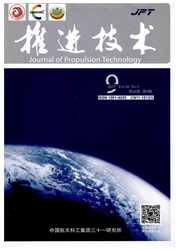

 中文摘要:
中文摘要:
为得到入射激波强度对抛物形凹腔内激波反射聚焦过程的影响,采用结构自适应加密网格和波传播算法,计算马赫数分别为1.1、1.3、1.5、2.0、3.0和4.0的平面入射激波在二维抛物形凹腔内的反射和聚焦过程。计算结果表明:入射激波在凹腔壁面上的反射依次为直接马赫反射、反转马赫反射和过渡规则反射;三波点及马赫干在对称面上的碰撞是形成高能区域的原因;随激波强度增加,在凹腔壁面反射的激波由在聚焦前后都在对称面上反射变为只在聚焦后反射,再到最后不会反射;三波点在壁面上的反射和在对称面上的反射随入射激波马赫数增大,其距离和时间间隔缩小。
 英文摘要:
英文摘要:
In order to obtain the influence of incident shock strength on the focusing of shock wave in a parabolic cavity, the adaptive refined mesh and wave propagation method are used to simulate the reflection and focusing of planar shock wave in a 2D parabolic cavity with incident shock Mach numbers of 1. 1, 1.3, 1.5, 2.0, 3.0 and 4.0. Numerical results indicate that the reflection of incident shock from the cavity wall is direct Mach reflection, invert Mach reflection and transition regular reflection in order. High energy zone is resulted from the collision of triple points as well as Mach stems. The shock wave reflecting from the cavity wall before and after focusing only reflects from symmetry plane after focusing and finally does not reflect as the incident shock strength increases. The distance and interval between triple points reflecting from wall and symmetry plans decrease with the increase in the Mach number of incident shock wave.
 同期刊论文项目
同期刊论文项目
 同项目期刊论文
同项目期刊论文
 期刊信息
期刊信息
